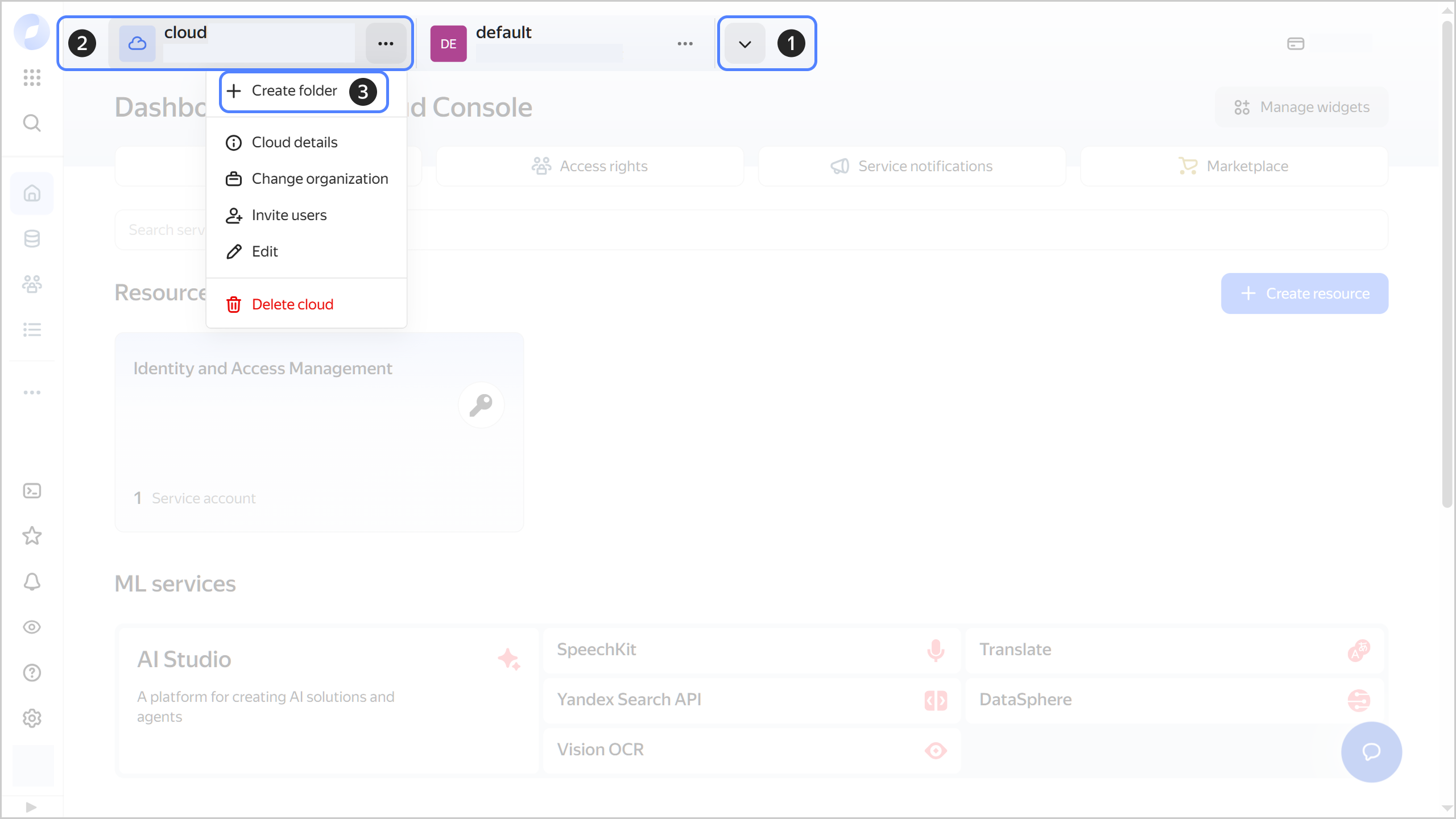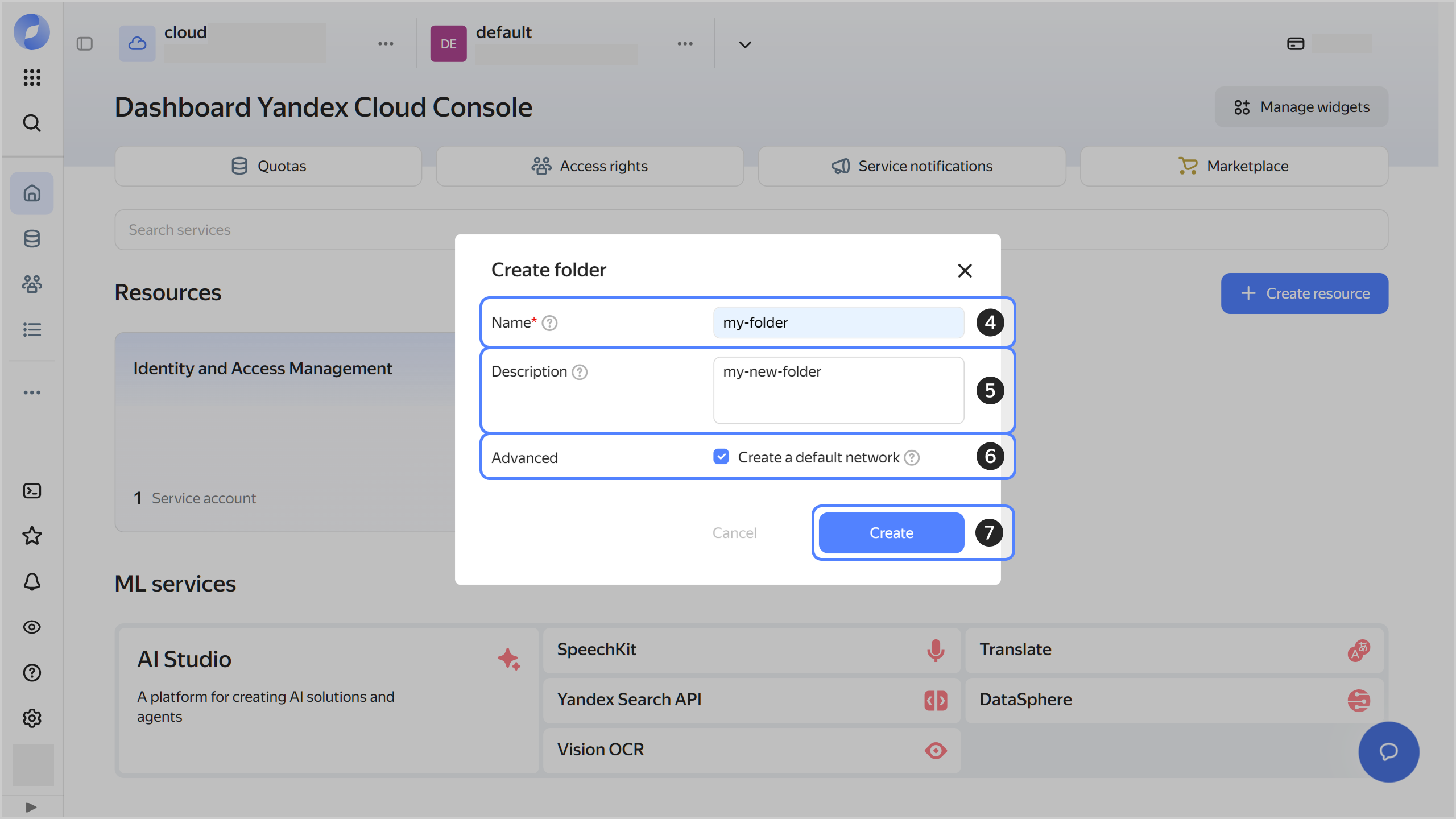Getting started with Yandex Cloud CDN
Use an Object Storage bucket to demonstrate how to set up content delivery over a CDN:
- Create a CDN resource.
- Upload your content to the CDN.
- Set up a CNAME record for your domain.
- Test the CDN.
Getting started
-
Make sure you have a domain name and can access the DNS settings on your DNS hosting provider’s website. This is typically your domain registrar.
-
Navigate to the management console
-
If you do not have a folder yet, create one:
-
In the management console
-
To the right of the cloud name, click
-
Select Create folder

-
Give your folder a name. The naming requirements are as follows:
- It must be from 2 to 63 characters long.
- It can only contain lowercase Latin letters, numbers, and hyphens.
- It must start with a letter and cannot end with a hyphen.
-
Optionally, specify the description for your folder.
-
Select Create a default network. This will create a network with subnets in each availability zone. Within this network, you will also have a default security group, within which all network traffic will be allowed.
-
Click Create.

-
-
If you do not have an Object Storage bucket yet:
-
Enable public access to the objects in the bucket and the object list.
-
Upload your content to the bucket.
Note
For details on creating a source group and a CDN resource with other source types, see these pages:
Create a CDN resource
-
Go to Cloud CDN.
-
In the
-
Configure the basic CDN resource settings:
-
Under Content:
-
Enable Enable access to content.
-
In the Content query field, select
From one origin. -
In the Origin type field, select
Bucket.Note
For details on creating a source group and a CDN resource with other source types, see these pages:
-
In the Bucket field, select the bucket you created in Object Storage.
-
In the Origin request protocol field, select
HTTP. -
In the Domain name field, specify the primary domain name you will use in your website links to CDN-hosted content, e.g.,
cdn.example.com.Alert
You cannot change the primary domain name used for content distribution after creating a CDN resource.
-
-
Under Additional settings:
-
In the Redirect clients field, select
Don't use. -
In the Certificate type field, select
Don't use. -
In the Host header field, select
Custom. -
In the Header value field, specify the domain name from the bucket URL in
<bucket_name>.storage.yandexcloud.netformat, omitting the schema (httporhttps). Here is an example:my-bucket.storage.yandexcloud.netWarning
If the
Hostheader is misconfigured, Object Storage will return errors in response to CDN server requests.
-
-
-
Click Continue.
-
Under Caching, HTTP headers and methods, and Advanced, leave the default settings. Click Continue.
Tip
You can configure these settings later, if required.
Upload your content to the CDN
Tip
We recommend preloading large content to the CDN, e.g., files larger than 200 MB. This is an optional step. If skipped, the CDN will load the content automatically when a user tries to access it for the first time.
To prefetch content to CDN servers:
-
On the CDN resource page, navigate to the
-
In the top-right corner, click
-
In the File path field, enter the names of the files stored in the bucket, omitting the bucket name. See an example below:
/index.html /static/styles.css /static/app.js -
Click Preload content.
Set up a CNAME record for your domain
-
In the
328938ed********.a.yccdn.cloud.yandex.netformat. -
Navigate to your domain’s DNS settings on your DNS hosting provider’s website.
-
Edit the relevant CNAME record so that it points to the previously copied URL in the
.yccdn.cloud.yandex.netdomain. For example, if the domain name you specified when creating your CDN resource iscdn.example.com, you need to create the following CNAME record or use it to replace the current record forcdn:cdn CNAME 328938ed********.a.yccdn.cloud.yandex.net.Note
Do not use an ANAME resource record with domain names for content distribution; otherwise, the end user will get a response from a CDN server not linked to the user geolocation. The response will always be the same for all users.
Test the CDN
-
Wait for the DNS records to update. This may take several hours.
-
Make sure the
cdnCNAME record in the DNS server's cache points to the generated URL, e.g.,328938ed********.a.yccdn.cloud.yandex.net. -
Open the website in your browser to make sure it is working. Here is an example:
http://cdn.example.com/index.html